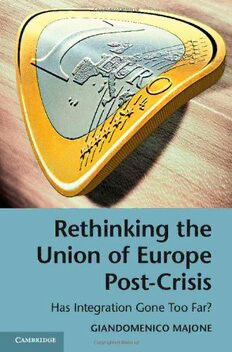
Rethinking the Union of Europe Post-Crisis: Has Integration Gone Too Far? PDF
Preview Rethinking the Union of Europe Post-Crisis: Has Integration Gone Too Far?
RETHINKING THE UNION OF EUROPE POST-CRISIS Inthisimportantnewbook,GiandomenicoMajoneexaminesthecrucial but often overlooked distinction between the general aim of European integrationandthespecificmethodofintegrationemployedindesigning a(ill-considered)monetaryunion.Writtenwiththeauthor’scustomary insight andprecision,thishighlytopicalandprovocativebookreviews theUnionleaders’traditionofpushingthroughambitiousprojectswith- outconsideringtheserioushurdlesthatlieinthewayof theirsuccess. RegionalandEuropeanintegrationtopicsarediscussed,includingcred- ibilityofcommitments,delegationofpowers,bargainingandinfluence activities, adverse selection and moral hazard. The author also offers a deeperexaminationof thespecificcrisisofmonetaryintegration,arguing thatintegrationmightbeachievedmoreeffectivelywithinter-jurisdictional competition, and suggests how integration should be managed in the globalizedworld. giandomenico majone isEmeritusProfessorofPublicPolicyatthe EuropeanUniversityInstituteinFlorence. RETHINKING THE UNION OF EUROPE POST-CRISIS Has Integration Gone Too Far? GIANDOMENICO MAJONE UniversityPrintingHouse,CambridgeCB28BS,UnitedKingdom CambridgeUniversityPressispartoftheUniversityofCambridge. ItfurtherstheUniversity’smissionbydisseminatingknowledgeinthepursuitof education,learningandresearchatthehighestinternationallevelsofexcellence. www.cambridge.org Informationonthistitle:www.cambridge.org/9781107694798 ©GiandomenicoMajone2014 Thispublicationisincopyright.Subjecttostatutoryexception andtotheprovisionsofrelevantcollectivelicensingagreements, noreproductionofanypartmaytakeplacewithoutthewritten permissionofCambridgeUniversityPress. Firstpublished2014 PrintedintheUnitedKingdombyClays,StIvesplc AcataloguerecordforthispublicationisavailablefromtheBritishLibrary LibraryofCongressCataloguinginPublicationdata Majone,Giandomenico. RethinkingtheunionofEuropepost-crisis:hasintegrationgonetoo far?/GiandomenicoMajone. pages cm ISBN978-1-107-06305-1(hardback) 1. EuropeanUnioncountries–Economicintegration. 2. EuropeanUnioncountries– Economicintegration–Politicalaspects. 3. EuropeanUnioncountries–Economic policy. 4. EuropeanUnioncountries–Politicsandgovernment– 21stcentury. I. Title. HC241.M256 2014 337.1042–dc23 2013046218 ISBN978-1-107-06305-1Hardback ISBN978-1-107-69479-8Paperback CambridgeUniversityPresshasnoresponsibilityforthepersistenceoraccuracyof URLsforexternalorthird-partyinternetwebsitesreferredtointhispublication, anddoesnotguaranteethatanycontentonsuchwebsitesis,orwillremain, accurateorappropriate. CONTENTS ListofAbbreviations pagevi Introduction:varietiesofregionalintegration 1 1 Monetaryunionasametaphor 20 2 Apoliticalcultureoftotaloptimism:itsriseandfall 58 3 Integrationanditsmodes 88 4 Deepeningintegration:transactioncosts andsocio-politicallimits 118 5 Europeanintegrationandthedecouplingofpolitics andeconomics 149 6 Fromthedemocraticdeficittoademocraticdefault? Thenormativedimensionoftheeurocrisis 179 7 ‘MoreEurope’ 208 8 ThelimitsofleaderlessEurope 236 9 Integrationthroughcooperativecompetition 266 10 Thenationstatebetweenglobalizationandregional integration 295 Bibliography 323 Index 337 v ABBREVIATIONS ACP African,Caribbean,andPacific(countries) ANZCERTA Australia–NewZealandCloserEconomicRelationsTrade Agreement BRIC Brazil,Russia,India,China BVG Bundesverfassunsgericht CAP CommonAgriculturalPolicy CFSP CommonForeignandSecurityPolicy CJEU CourtofJusticeoftheEuropeanUnion Coreper CommitteeofPermanentRepresentativesofthenational governments CUSTA Canada–UnitedStatesFreeTradeAgreement DSB Dispute-settlementbodies DSM Dispute-settlementmechanisms DSU DisputeSettlementUnderstanding EC EuropeanCommunity ECB EuropeanCentralBank ECHR EuropeanConventionfortheProtectionofHumanRightsand FundamentalFreedoms ECJ EuropeanCourtofJustice ECOFIN CouncilofthefinanceministersoftheEU ECSC EuropeanCoalandSteelCommunity ECU EuropeanCurrencyUnit EEC EuropeanEconomicCommunity EFTA EuropeanFreeTradeArea EMS EuropeanMonetarySystem EMU EconomicandMonetaryUnion EP EuropeanParliament EPU EuropeanPoliticalUnion ERM ExchangeRateMechanism ESCB EuropeanSystemofCentralBanks ESM EuropeanStabilityMechanism EU EuropeanUnion EURATOM EuropeanAtomicEnergyCommunity GATT GeneralAgreementonTariffsandTrade vi abbreviations vii GDP grossdomesticproduct GSP GrowthandStabilityPact IMF InternationalMonetaryFund ITF InternationalTransportWorkersFederation JHA JusticeandHomeAffairs MEP MemberoftheEuropeanParliament MERCOSUR MercadoComùndelSur MTBO Medium-termbudgetaryobjective NAFTA NorthAmericanFreeTradeAgreement NATO NorthAtlanticTreatyOrganization OECD OrganizationforEconomicCooperationandDevelopment OMC OpenMethodofCoordination PP PrecautionaryPrinciple SGP StabilityandGrowthPact SPS SanitaryandPhytosanitary(Agreement) StabilityTreaty TreatyonStability,CoordinationandGovernanceinthe EconomicandMonetaryUnion2012 TCE Transaction-costeconomics TCP Transaction-costpolitics TEU TreatyontheEuropeanUnion TFEU TreatyontheFunctioningoftheEuropeanUnion WTO WorldTradeOrganization u Introduction: varieties of regional integration Regionalism,oldandnew The revivalofregionalintegrationin the 1980s–which JagdishBhagwati (1993) labelled the ‘Second Regionalism’, in contrast to the ‘First Regionalism’ of the 1960s – raises a number of issues, starting with the questionwhythefirstregionalismfailed(withthenotableexceptionofthe European Economic Community (EEC)), while this time regionalism is likelytoendure.TheconversionoftheUnitedStates(US)toregionalismis ofmajorsignificanceinthisrespect.Asthekeyadvocateofmultilateralism through the post-war years, its decision to travel the regional integration routeseemstohavetiltedthebalanceatthemarginfrommultilateralismto regionalism. A second important factor has been the widening and deep- ening of the European Community/Union (EC/EU). Thus, the fear that European investments would be diverted to Eastern Europe was cited by President Salinasof Mexicoasafactor decisivelypushinghimtowardthe NorthAmericanFreeTradeAgreement(NAFTA).Hefeltthatafreetrade area embracing all of North America would enable Mexico to get the investments needed from the US and Canada, as well as from Japan (Bhagwati1993;VegaCànovas2010).InhiscommentonBhagwati’sarticle, Robert Baldwin considered the likelihood of a gradual drift of the North American regional bloc to include a number of other Latin American countries. This enlargement would be driven by pressures from these countries to tap into the US market but another important factor that might drive the expansion of an American-centred bloc, according to Baldwin, ‘would be the growing influence of the European Community in trade, macroeconomic and foreign policy matters. US political and economicleadersmayadopttheviewthatitisnecessarytoexpandsucha blocinordertomatchtheincreasingpoliticalandeconomicpowerofthe Community’(Bhagwati1993:54). Adistinguishingcharacteristicofthenewregionalismisthemovement fromshallowintegration–integrationbasedontheremovalofbarriersto 1
